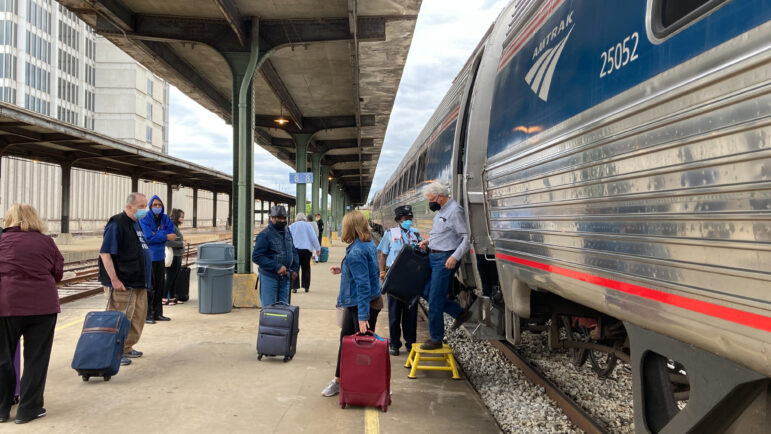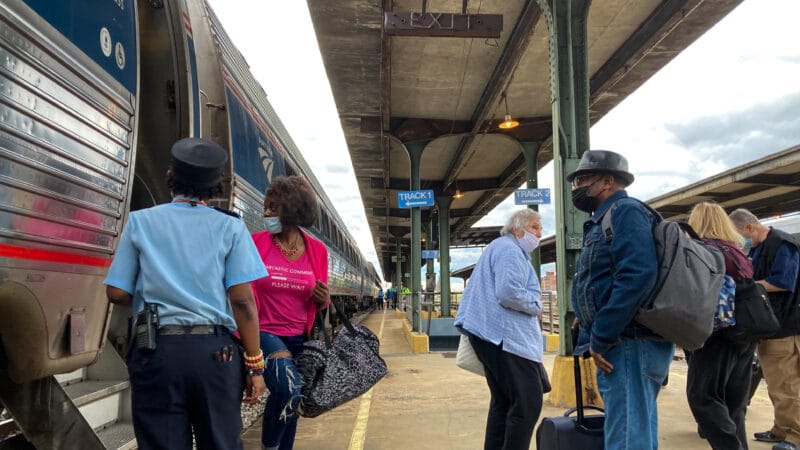The fate of Amtrak’s Mobile to New Orleans line will be decided by these key issues
Amtrak is making its final pitch to federal regulators for a new passenger line connecting New Orleans and Mobile, Alabama.
But the private companies that own the tracks Amtrak’s trains would use are opposing the deal, arguing that the extra trains would cause significant harm to their freight business. The two sides have been battling it out for weeks, presenting their own witnesses and cross-examining their opponents in front of the federal regulators who will make the final decision to either greenlight or kill Amtrak’s plan.
There isn’t a clear deadline for a decision from the Surface Transportation Board, but Amtrak should have an answer soon on whether or not its trains can return to the Gulf Coast.
This marks the biggest decision yet in a quarrel over returning passenger service to the railroad for the first time since Hurricane Katrina, though the ruling could be appealed in court. The judgment here will also potentially set a precedent, with Amtrak’s national expansion ambitions hinging on what happens with these roughly 150 miles of railroad.
Here are four issues that the federal board will consider when making its decision.
Who’s going to pay for it — and how much?
Adding more trains to the line means spending more money, but Amtrak and the companies disagree on who should pick up the tab.
From the perspective of the private railroads — CSX and Norfolk Southern — Amtrak should foot the bill for changes to its tracks if it wants to run on them.
Adding passenger trains onto a railroad isn’t as simple as cars sharing a highway with 18-wheelers because much of the Gulf Coast line is one track. There are passing lanes, but often, CSX runs freight trains that are too long for them.
The company argues that it’ll need new infrastructure to keep the trains running on time but its estimates for how much that would cost have swung wildly over the years. At one point, the company estimated upgrades would cost at least $1.1 billion. Now, the company puts the figure at $440 million.
Part of what makes this line so expensive to run — even without Amtrak — comes down to location. Hurricanes mean frequent repairs and, according to the company, the line is five times more expensive to maintain than its other routes.
The railroads also argued that Amtrak has the money to pay for the infrastructure needed to avoid delays. As part of the infrastructure law passed by Congress last year, Amtrak received $66 billion. Surface Transportation Board members, however, have differing ideas about what Amtrak could do with that money.
Board Member Karen Hedlund said it’s a reason to reach a deal quickly — the money from Congress could be assigned to other lines while the Gulf Coast service hangs in limbo. Chairman Martin Oberman cautioned that just because taxpayer dollars are available doesn’t mean it’s appropriate to spend here.
Amtrak dismissed the call for the agency to cover infrastructure counts on two grounds. First, it disputes even CSX’s lower estimate of $440 million. That works out to about $3 million per mile while the railroads spend significantly less elsewhere in the country, according to Amtrak.
“That is a model designed to gold plate a railroad,” Jessica Ring Amunson, an attorney representing Amtrak, said.
Second, Amtrak argues that it has no obligation to pay for any infrastructure because the tracks the rail line would use are privately owned. Congress gave Amtrak the right to use these tracks when the agency was formed 50 years ago. In exchange, the private railroads were no longer required to run passenger services they were losing money on while Amtrak paid them operating fees.
Covering infrastructure to avoid delays was never part of the bargain, Amtrak argues, and it would be inappropriate for the agency to spend taxpayer funds to build up a private company’s infrastructure.

How much is too much congestion?
Much of the federal board’s decision hangs on the definition of a two-word phrase: Unreasonable impairment.
Amtrak has the right to use any private railroad in the country, but the board must consider if adding a passenger train would cause a traffic jam beyond what is acceptable – though the board is asking both sides for help in figuring out what’s acceptable versus unreasonable.
CSX said its model shows the Amtrak trains would quickly lead to 13 hours worth of delays each day and a 45% increase in delays to train traffic around Mobile, Alabama. By 2042, the model shows these tracks being completely gridlocked.
“That is unreasonable impairment under any definition of the word unreasonable,” Raymond Atkins, an attorney for CSX, said.
Amtrak concedes its plans would cause delays for the railroads, but said that’s just the nature of sharing the railroads — something Amtrak and other freight companies successfully do on other, busier lines across the country.
In a rebuttal, the agency said it’s unrealistic to account for hypothetical situations two decades from now. It also pointed out that the delay estimates CSX gave are based on the railroads not making changes to respond to the new service, like improving train schedules or running shorter trains.
CSX’s percentages also lose their drama when converted to real numbers, according to Amtrak. A passenger line would cause freight trains to slow down by .7 miles per hour — from 14.8 to 14.1.

Aggression vs. stalling
Hurricane Katrina’s destruction on the Gulf Coast in 2005 marked the end of passenger rail service on the line at the center of the hearings, and Amtrak believes it is overdue for a comeback.
But over the past decade-plus, Amtrak and the railroads have gone back-and-forth on how to share the tracks — often running into roadblocks with accusations of Amtrak being too aggressive and the railroads purposely stalling negotiations.
The two were working together on a Rail Traffic Controller study, the industry standard used to understand the impact of other Amtrak lines. But according to CSX, Amtrak abandoned the study in Feb. 2021 a few months from completion. Instead, the agency went to the STB in hopes of getting an order forcing the railroads to let Amtrak start running its trains.
From the railroad’s perspective, Amtrak was less interested in cooperation than in creating a precedent to fast-track its countrywide expansion ambitions.
“Let there be no doubt — Amtrak’s demands are aggressive,” Atkins said. “Amtrak maintains it is entitled to immediate access to the Gulf Coast line without any study of the impact or a single penny of infrastructure.”
Amtrak disagrees, calling the study meaningless since the railroads refused to share operating information they claimed as confidential. Instead, the agency said the study was part of a long pattern of the railroad companies delaying Amtrak’s return to the Gulf Coast.
That claim showed up again when the companies asked the federal board to order mediation between all sides just a few weeks before this hearing, which itself took more than a year to begin after Amtrak’s initial request. Then, during the hearing, the railroads said the proceedings should take place under a different statute, which would have caused several more months of delays.
The hearings themselves have also been an example of how this process has dragged on. The board initially scheduled them to last only two days at the start of April. But, that quickly ballooned to eight days across three weeks. The arguments are paused, for now, set to resume again on May 9.
The railroads have hinted that the fight could continue well beyond this hearing as well. Atkins accused board members of advocating for Amtrak in their questioning of experts, which could be used as the basis to appeal the board’s final decision and bring the conflict to an appellate court.
“You are charged by Congress and stepping into the role of a judge and you can overstep those bounds if your questioning is too partisan or too extensive,” Atkins said.
Oberman, however, rejected Atkin’s point, saying it was the board’s duty to get to the truth and he would not prevent board members from asking questions.
National implications
The board has another issue to consider, and it’s one that goes far beyond the Gulf Coast — the country-wide precedent their decision will make.
The ruling the five board members make will be used as a guideline for other disputes between passenger rail and railroads — conflicts soon to arise and some that have already started.
To celebrate Amtrak’s 50th anniversary and out of anticipation of the then-still-not-passed infrastructure law, the agency released a map last year outlining its ambition for about 30 new routes across the country.
But adding new routes and expanding others requires negotiations with private railroads, like the one currently happening along the Gulf Coast. Several rail experts believe this is why the companies have fought so hard against this line — a win here for Amtrak will make expansion elsewhere that much easier, allowing the agency to use it as precedent. A loss will mean Amtrak can expect similarly pained and slow arbitration on all those dreamed routes.
That’s also why a public hearing on the issue in February drew speakers from Ohio, Pennsylvania and elsewhere across the country. While the board spends long days listening to testimony on this line’s technicalities, computers across the country stream these Zoom proceedings, with viewers wondering what this will mean for the railroad tracks connecting their cities.
This story was produced by the Gulf States Newsroom, a collaboration among Mississippi Public Broadcasting, WBHM in Alabama and WWNO and WRKF in Louisiana and NPR.
‘Bomb cyclone’ forecasted to bring heavy snow, blizzard conditions and dangerous travel
A 'bomb cyclone' is intensifying severe winter weather for millions of people across the U.S. The system is expected to knock out power and disrupt holiday travel.
Russia sends 3 Iranian satellites into orbit, report says
The report said that a Russian rocket sent the satellites on Sunday from a launchpad in eastern Russia.
Viral global TikToks: A twist on soccer, Tanzania’s Charlie Chaplin, hope in Gaza
TikToks are everywhere (well, except countries like Australia and India, where they've been banned.) We talk to the creators of some of the year's most popular reels from the Global South.
This painting is missing. Do you have it?
An important work from a rediscovered artist has been absent from public view since the 1970s. A New York curator is hunting for it.
Memory loss: As AI gobbles up chips, prices for devices may rise
Demand for memory chips currently exceeds supply and there's very little chance of that changing any time soon. More chips for AI means less available for other products such as computers and phones and that could drive up those prices too.
Brigitte Bardot, sex goddess of cinema, has died
Legendary screen siren and animal rights activist Brigitte Bardot has died at age 91. The alluring former model starred in numerous movies, often playing the highly sexualized love interest.








